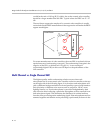
Design Guide for the Polycom SoundStructure C16, C12, C8, and SR12
B - 26
device, the reinforcement of the ceiling loudspeakers can be delayed slightly
(1 msec for each foot of separation) from the front loudspeakers and can be
attenuated by approximately 6 - 10 dB from the level sent to the front of room
loudspeakers.
Microphone And Loudspeaker Placement Considerations
Once loudspeakers have been placed through the room to achieve good sound
coverage, and microphones have been placed through the room to provide
good sound pickup, it is still necessary to double check the placement of the
microphones relative to the loudspeakers to ensure the ERL of the
conferencing system hasn't been compromised in the process. If loudspeakers
are placed in the direct pick up pattern of the microphone, the ERL will be
reduced and there is a higher chance of residual echo being sent to the remote
participants. Typically the configuration software with the audio conferencing
product will provide a tool where the ERL can be checked to ensure it is within
the recommended operating range for that particular audio conferencing
device (typically 0 to 10 dB). If the recommended ERL is exceeded, it will be
necessary to review the gain structure (lowering the loudspeaker amplifier
settings and increasing the remote audio levels), ensuring the loudspeakers
are pointed directly into the pick up pattern of the microphones, or lowering
the gain on the microphones.
In-Room Reinforcement
In a given room, sound reinforcement may be desirable if it is not possible to
have listeners easily hear other talkers in the room. The objective of this type
of sound reinforcement (sometimes referred to as "voice lift" in the generic
sense) is to augment the local talker's voice so that local listeners still have the
perception that the audio is originating from the local talker but now the level
of the speech has been increased subtly via the installed loudspeaker system.
One of the keys to making a system of this type stable and work reliably is
properly setting user expectations and perception. It is critical that the users do
not expect audio levels similar to a “paging system” or “public address” (PA)
system. Paging and PA systems are designed to broadcast a single voice
loudly, overcoming background noise, side conversations, and inattention in
order to deliver important messages. The sound levels generated by these
systems are much louder than local participants in a room would ever need to
subtly reinforce their voice and maintain the perceptual directionality so the
local listeners' attention remains focused on the talker and not on the
loudspeaker.
Voice reinforcement or enhancement is supposed to be just that; reinforcing
the level of the talker to improve intelligibility and not re-create the sound
level of an emergency page. In a properly configured and calibrated voice lift
system, the best way to find out if the system is functioning properly is to
disable it and see if the local participants notice the resulting loss of


















